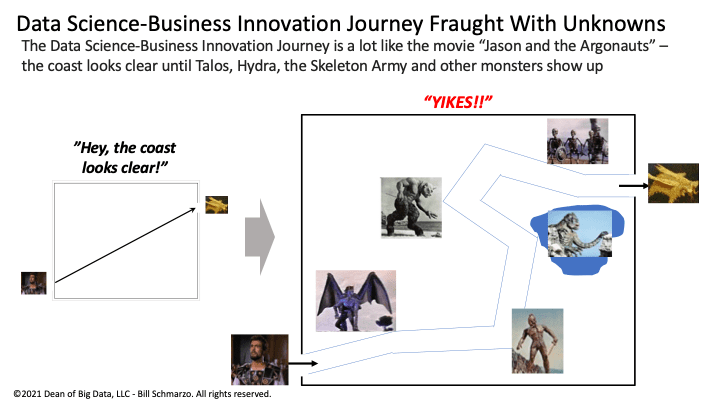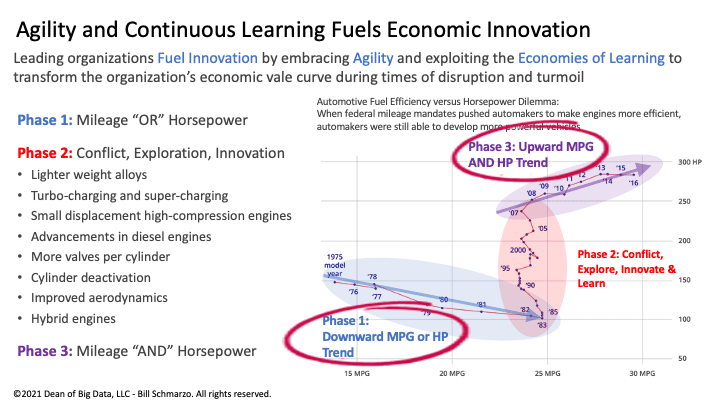
A recent HBR article, “Why Do Chief Data Officers Have Such Short Tenures?” by Thomas Davenport, Randy Bean, and Josh King, highlighted the Chief Data Officer’s (CDO) “Data-to-Business Innovation” challenge. The main charter for the CDO is to accelerate the Data-to-Business Innovation flywheel; to guide the business in becoming more effective at leveraging data and analytics to optimize its key business and operational use cases (Figure 1).

Figure 1: Data-driven Value Creation Flywheel
But the reality is a wicked master. The average tenure for a CDO is 2.5 years, about the same as an NFL running back (2.53 years). And while the CDO is hailed as a digital transformation savior upon arrival, the expectations of building out the organization’s data and analytic capabilities while simultaneously delivering short-term business impact becomes too overwhelming. Consequently, “Exit, stage left”.
The CDO Data-to-Business Innovation Dilemma
CDO Data-to-Business Innovation Dilemma: Deliver meaningful and relevant business outcomes in the short term while simultaneously and continuously building and transforming the organization’s data and analytics assets and capabilities.
The key to addressing the CDO Data-to-Business Innovation Dilemma is to view the development of the organization’s data and analytics plan as a journey, not an event. Treating your data and analytics plan like an event (and hiring some high-powered consulting company to build that plan for you) is like trying to build the “perfect” football game plan before the game begins and then being forced to adhere to that “perfect” game plan no matter what happens during the game.
As Mike Tyson famously said, “Everyone has a plan until they get punched in the mouth.” And that’s the problem with developing that comprehensive data and analytics plan – the data and analytics plan is constantly being punched in the mouth.
The data and analytics plan is fraught with unknown business, organizational, and technology challenges that only surface as the data science and business teams move along the data and analytics journey. Like the movie “Jason and the Argonauts”, a data and analytics plan must be prepared for whatever is thrown at them (like that darn skeleton army), and then pivot and adjust accordingly (Figure 2).

Figure 2: The Data and Analytics Journey is Fraught with Unknowns
The only way to thrive in an environment of constant change, disruption, and transformation is to be agile and empower the organization’s ability to continuously learn and adapt as they interact and react to their environment.
What Do We Mean by Agile?
Agile is one of those concepts that are absolutely great…as long as the other party has to be agile. Some folks like to wave “agile” around like it’s a magic sword, able to slay all sorts of dragons and unknown beasts. But ask them to become agile, and they mutter and stumble around as if you’ve asked them to walk in the sun.
History has shown that survival depends on agility. For example, if you had challenged the car manufacturers in 1979 to increase automobile horsepower (HP) while also increasing mileage per gallon (MPG), auto executives would have looked at you like you had lobsters crawling out of your ears. However, that is exactly what happened.
The U.S. Government-mandated higher fuel mileage in 1975 and again in 2007. And instead of going out of business, most car manufacturers embraced agility and continuous learning and adapting in attacking the “Mileage versus Horsepower” challenge (Figure 3).

Figure 3: Agility and Conflict Fuels Economic Innovation
Automobile manufacturers embraced a culture of continuous learning by ideating, trying, failing, learning, unlearning, and trying again in transforming the industry’s economic value curve from the Phase 1 downward “Mileage OR Horsepower” trend to the Phase 3 upward “Mileage AND Horsepower” trend in Figure 3.
Economic Value Curve is a measure of the relationship between a dependent variable and independent variables to achieve a particular outcome, such as retaining customers, increasing operational uptime, or optimizing inventory. The Economic Value Curve measures the impact of increasing or decreasing one of the independent variables on the dependent variable.
The automobile industry achieved something that many believed was unachievable by creating an agile organizational mindset that exploited the economies of learning.
Importance of Creating an Economies of Learning Mindset
Economies of Scale are the cost advantages that enterprises obtain due to their scale of operation and are typically measured by reduced cost per output.
Traditionally, large organizations have leveraged Economies of Scale to lock smaller players and new competitors out of markets by tying up key ecosystem players (suppliers, distributors). This Economies of Scale approach works great in a world where things don’t change.
Unfortunately, Economies of Scale can yield Diseconomies of Scale, which can become an albatross around your neck in a world under pressure from pandemics, wars, technology disruptions, social challenges, environmental mandates, economic disruptions, and political turmoil. The results of the Diseconomies of Scale and building rigid economies of scale business model are (Figure 4):
- Shrinking Marginal Revenues due to rigid legacy systems, processes, and policies optimized for yesterday’s problems that inhibit rapid adaption to changing customer, competitor, economic, environmental, societal, and market demands.
- Rising Marginal Costs due to the compounding cost disadvantages associated with increased organizational size, rigidity, and inertia.

Figure 4: Diseconomies of Scale Ramifications
What can a CDO do to survive in this environment and extend their playing career? Embracing agility and creating an “economies of learning” mindset is not just key; it’s mandatory.
Agility and Economics of Learning Summary
The ability of an organization to constantly learn and adapt is the hallmark of a successful organization. And that is especially true in developing an organization’s data and analytics capabilities and assets.
And remember, developing a data and analytics plan is a journey, not an event (channel your inner Michael Tyson and Jason and the Argonauts to guide and survive your journey).
In Part 2 of this series, I’ll introduce some CDO Agility Guidelines that can help the CDO to embrace agility and create the “economies of learning” mindset necessary to address the Data-to-Business Innovation Challenge.
